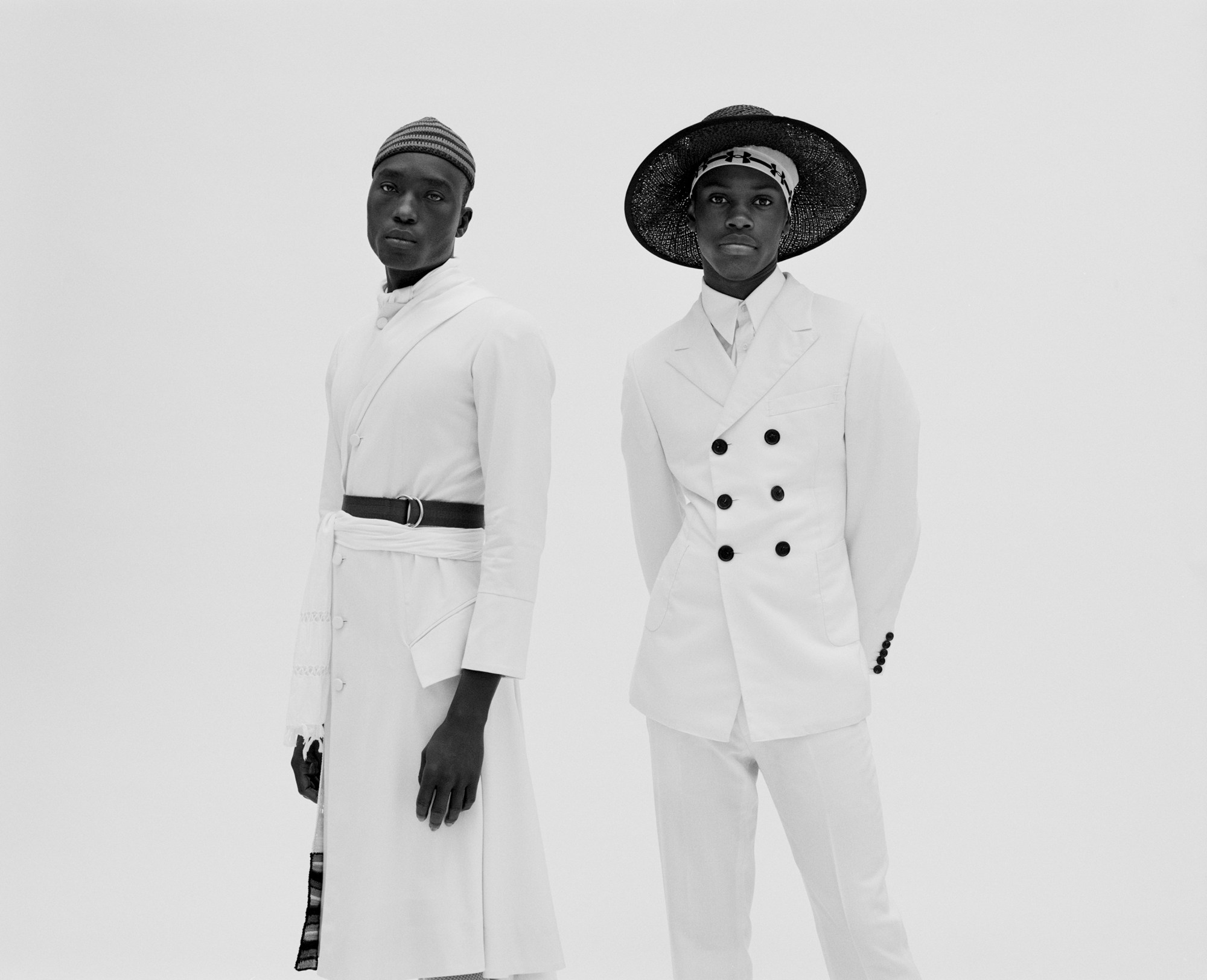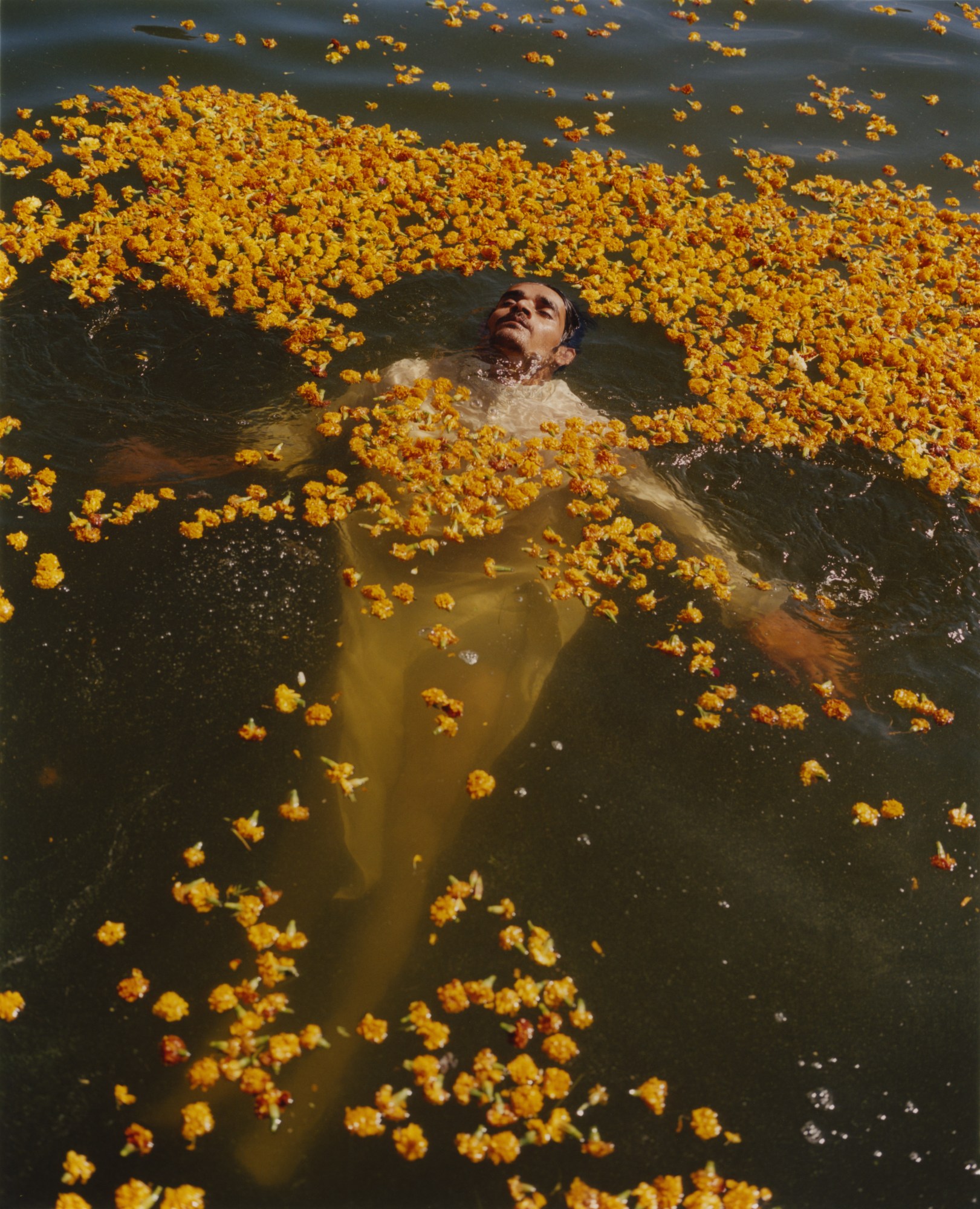As hastily made resolutions fade to distant memory, 2019 stretches languidly before us, rudderless with the possibility of the unknown. It’s the hazy mood which menswear designer Grace Wales Bonner taps into with Grace Wales Bonner: A Time for New Dreams, a new exhibition at the Serpentine’s Sackler gallery that traverses themes of spirituality, mysticism, rhythm and temporality.
“I guess the way I’ve always thought about time was quite free,” the British-Jamaican designer tells i-D. “The way I reference different histories and different rhythms. Temporality is a very important part of how I think.” Moving from fashion to art has required a step-change for the designer. “It’s interesting now to be working in the art world and to understand the different rhythms and pace of that, and to see the strengths of pace in some ways.”
Back in 2014, Grace Wales Bonner’s graduate collection Afrique won the L’Oréal Professionnel Talent Award. The following year, the designer launched her eponymous menswear label Wales Bonner with Ebonics, a debut collection for which she was awarded Emerging Menswear Designer at the British Fashion Awards. Next came the LVMH Young Designer Prize, and then, in October last year, Wales Bonner was awarded the 2018 Emerging Design Medal at the London Design Festival, an award which has previously honoured design luminaries including starchitects Thomas Heatherwick and the late, great Zaha Hadid.
Apparently not content with commanding the notoriously hard-to-earn respect of fashion and design’s leading decision makers, Grace Wales Bonner’s latest project sees the designer laying claim to the art world with a month-long exhibition at the Serpentine: a multi-sensory installation that invites visitors to meditate on themes of ritual, mysticism and spirituality.
It is not the first time that Grace Wales Bonner has worked with the gallery. In 2015, she took part in the Transformation Marathon, collaborating with the Serpentine’s energetic artistic director Hans Ulrich Obrist to send two musicians — Moussa Dembele and Moussa Dembele — out on stage robed in her glittering designs for a performance titled Everythings for Real.
Grace Wales Bonner: A Time for New Dreams follows experimental interdisciplinary Park Nights events at the gallery which have so far celebrated emerging artists including Jala Wahid and brands such as unisex fashion line Telfar. But Wales Bonner’s exhibition is the first at the Serpentine’s Sackler gallery curated by a fashion designer, marking the beginning of a new series of short projects which will bring a broad range of artistic practises into the gallery. Just how broad, only time will tell, although Grace Wales Bonner: A Time for New Dreams is set to leave a strong imprint.

Wales Bonner is famed for her academic approach to fashion design, conceptualised through historical sourcing, literary references and framed by critical theory, encouraging a contemplative approach from audience and consumer. The designer journeys beyond garments to construct whole universes supported by the visions of an ever-expanding network of artists, writers and performers. “Usually literature is the starting point to a lot of my collections,” Wales Bonner explains. “This time I’ve been thinking about ideas of ritual, mysticism and magic that are communicated in black aesthetics, and also thinking about the idea of magical realism.” Ritual, mysticism and magic may seem at odds with the cyclical commercialism which fuels the fashion industry season after harried season, but for Wales Bonner, spirituality is never far away.
“Spirituality is quite personal to me,” she admits. “It’s something that just comes up. I’m interested in how spirituality can be communicated through aesthetics. I’ve always been interested in those ideas and also how things that seemingly are intangible or invisible can materialise aesthetically.”

Grace Wales Bonner: A Time for New Dreams temporarily transforms the Sackler gallery into a spiritual realm. There are site-specific shrines inspired by the shrines of the Black Atlantic and constructed by Canadian artist Kapwani Kiwanga, American textile artist and “painter” Eric N. Mack, American photographer and artist Paul Mpagi Sepuya and Grace Wales Bonner, and carpet installations by American conceptual post black artist Rashid Johnson, which Wales Bonner hopes will imbue the Serpentine with “a sense of grounding”.
“The shrine is the idea of an assembled, improvised, repurposed gathering of objects or ideas or sentiments which are given an intention by acts of belief and activity around them,” Wales Bonner explains. “That’s something I’m also tracing in my research to other forms of black aesthetic practise. I see the shrine as a portal or access point into other spiritual realms or other histories or connections to ancestors.”
A non-physical shrine is manifested in the gallery space through sound thanks to Laraaji, an American musician whose instrumental skills include piano, zither and mbira, who Wales Bonner describes as “a mystic and sound healing practitioner”. Laraaji has been studying Eastern mysticism since the 1970s, when he began busking in New York before being “discovered” in Washington Square Park by Brian Eno. The pair have long planned to work together. Across the month, Laraaji will be leading a series of sound meditation workshops, “activating” the space.
“Something that was really important to me was this idea of grounding, physically, really into space, and kind of arriving somewhere,” she considers. “Your connection with these kind important and magical, loaded subjects. I think it was really about trying to have experiences which could really enrich that kind of contemplation and meditation. A slowing of time, and a different way of thinking about time. It’s very much about finding new ways to think about belief.”

Slowing, thinking, finding; Grace Wales Bonner: A Time for New Dreams is a thoughtful exhibition which will require a patient, analytical audience. “I hope people have quite intimate encounters with the shrines and that they can connect with the energy and the intentions behind the show.”
Those who may be more enamoured by Wales Bonner’s designs than the sometimes dense critical theory underpinning them will be pleased to learn that the month-long Serpentine show culminates in a presentation of Wales Bonner’s autumn/winter 19 collection. It is titled Mumbo Jumbo, a Victorian phrase used by writers Charles Dickens and Thomas Hardy and later reclaimed by American poet, novelist, essayist, songwriter, playwright, editor and publisher Ishmael Reed who penned a largely fictional postmodern novel of the same name which considers the influences on African diaspora and culture. This text, along with the writing of Robert Farris Thompson and Ben Okri’s Man Booker-winning novel, The Famished Road, heavily inspired both the collection and the exhibition.
Building on her process to date, Grace Wales Bonner: A Time for New Dreams is unique in that Wales Bonner has worked directly with the artists and writers that have inspired her rather than using their work as source material. “It’s probably quite new for me to work with writers because usually I’m responding to literature,” she explains. “To actually have an active conversation and develop ideas like I have done with Ben Okri — that’s been a real honour. I feel like each artist has enriched my approach to these ideas and my access points to them.” Despite Grace Wales Bonner’s rigorously academic approach, she insists that the exhibition’s themes can be universally understood. “I wanted this show to feel very inclusive and open and accessible,” she says. “I think we always need spiritualism. It’s always been a consistent thread through humanity.”

‘Grace Wales Bonner: A Time for New Dreams’ is at London’s Serpentine Galleries from 19 January to 16 February 2019.

